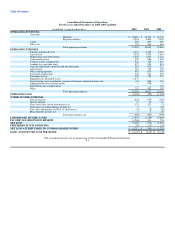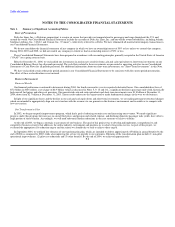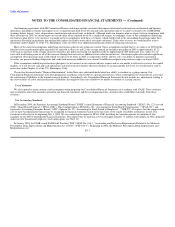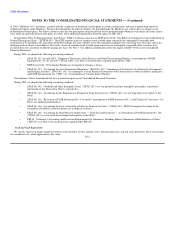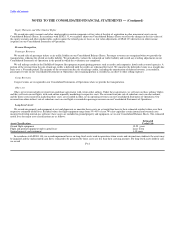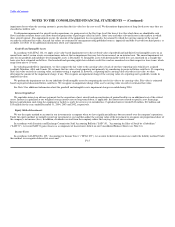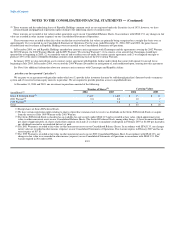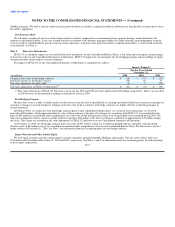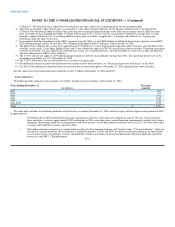Delta Airlines 2004 Annual Report Download - page 72
Download and view the complete annual report
Please find page 72 of the 2004 Delta Airlines annual report below. You can navigate through the pages in the report by either clicking on the pages listed below, or by using the keyword search tool below to find specific information within the annual report.
Table of Contents
NOTES TO THE CONSOLIDATED FINANCIAL STATEMENTS — (Continued)
impairment losses when the carrying amount is greater than the fair value less the cost to sell. We discontinue depreciation of long-lived assets once they are
classified as held for sale.
To determine impairments for aircraft used in operations, we group assets at the fleet type level (the lowest level for which there are identifiable cash
flows) and then estimate future cash flows based on projections of passenger yield, fuel costs, labor costs and other relevant factors in the markets in which
these aircraft operate. If an impairment occurs, the amount of the impairment loss recognized is the amount by which the carrying amount of the aircraft
exceeds the estimated fair value. Aircraft fair values are estimated by management using published sources, appraisals and bids received from third parties, as
available. See Note 14 for additional information about asset impairments.
Goodwill and Intangible Assets
In accordance with SFAS 142, we apply a fair value-based impairment test to the net book value of goodwill and indefinite-lived intangible assets on an
annual basis and, if certain events or circumstances indicate that an impairment loss may have been incurred, on an interim basis. The annual impairment test
date for our goodwill and indefinite-lived intangible assets is December 31. Intangible assets with determinable useful lives are amortized on a straight-line
basis over their estimated useful lives. Our leasehold and operating rights have definite useful lives and are amortized over their respective lease terms, which
range from nine to 19 years.
In evaluating goodwill for impairment, we first compare the fair value to the carrying value of each of our three reporting units which have assigned
goodwill: Mainline, ASA and Comair. We estimate the fair value of each reporting unit primarily by considering its projected future cash flows. If a reporting
unit's fair value exceeds its carrying value, no further testing is required. If, however, a reporting unit's carrying value exceeds its fair value, we then
determine the amount of the impairment charge, if any. We recognize an impairment charge if the carrying value of a reporting unit's goodwill exceeds its
implied fair value.
We perform the impairment test for our indefinite-lived intangible assets by comparing the asset's fair value to its carrying value. Fair value is estimated
based on projected discounted future cash flows. We recognize an impairment charge if the asset's carrying value exceeds its estimated fair value.
See Note 5 for additional information about the goodwill and intangible assets impairment charges recorded during 2004.
Interest Capitalized
We capitalize interest on advance payments for the acquisition of new aircraft and on construction of ground facilities as an additional cost of the related
assets. Interest is capitalized at our weighted average interest rate on long-term debt or, if applicable, the interest rate related to specific asset financings.
Interest capitalization ends when the equipment or facility is ready for service or its intended use. Capitalized interest totaled $10 million, $12 million and
$15 million for the years ended December 31, 2004, 2003 and 2002, respectively.
Equity Method Investments
We use the equity method to account for our investment in a company when we have significant influence but not control over the company's operations.
Under the equity method, we initially record our investment at cost and then adjust the carrying value of the investment to recognize our proportional share of
the company's net income (loss). In addition, dividends received from the company reduce the carrying value of our investment.
In accordance with Securities and Exchange Commission Staff Accounting Bulletin ("SAB") 51, "Accounting for Sales of Stock by a Subsidiary"
("SAB 51"), we record SAB 51 gains (losses) as a component of shareowners' deficit on our Consolidated Balance Sheets (see Note 16).
Income Taxes
In accordance with SFAS No. 109, "Accounting for Income Taxes" ("SFAS 109"), we account for deferred income taxes under the liability method. Under
this method, we recognize deferred tax assets and F-15


